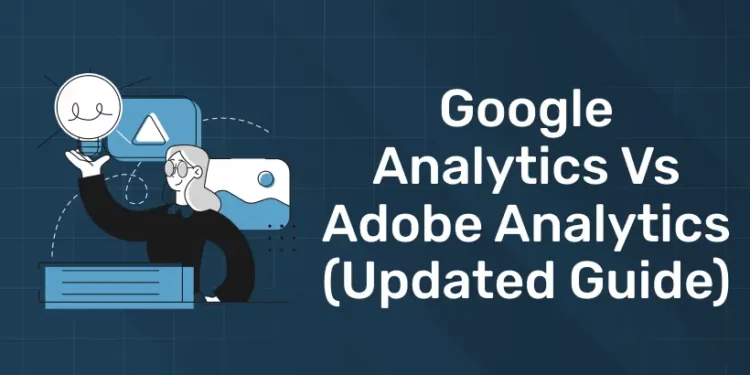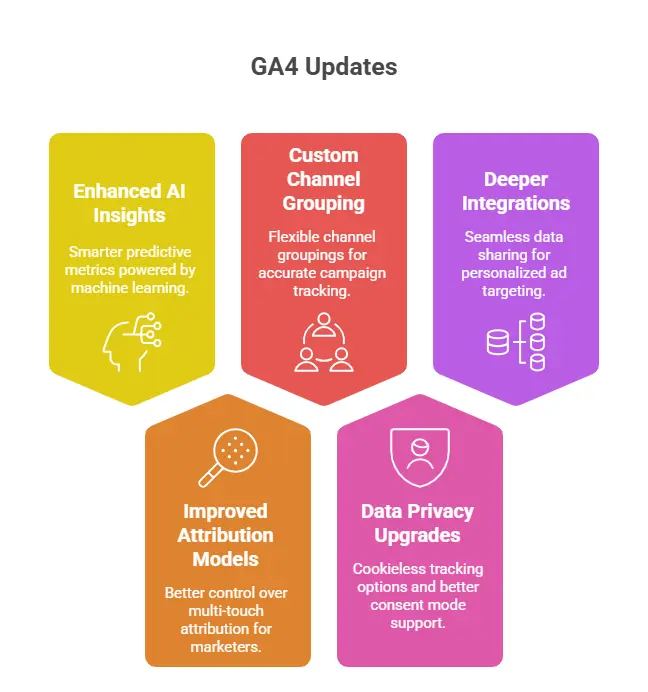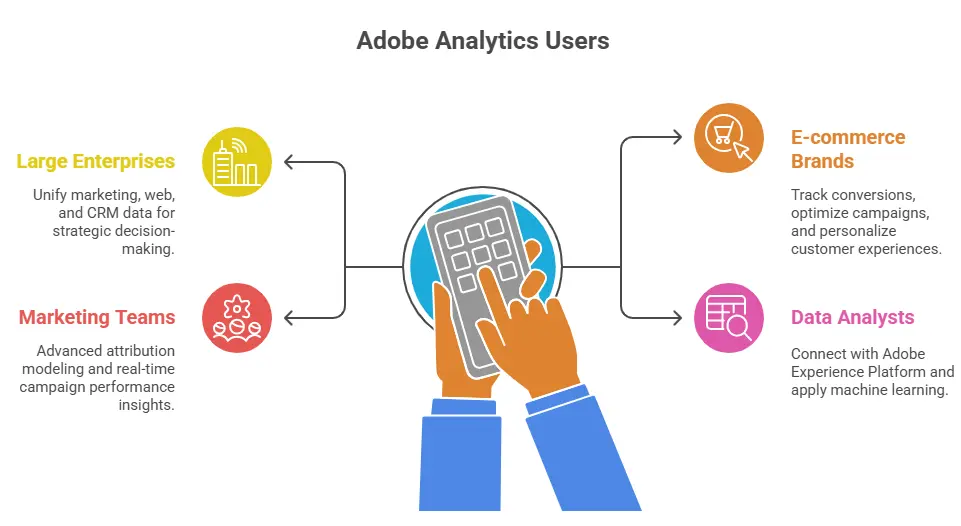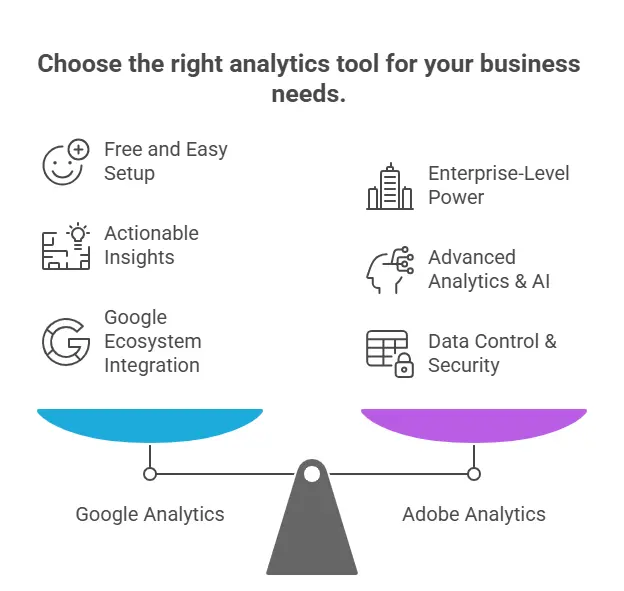Table of Contents
Analytics tools are essential for businesses today as they help you to understand customer behavior, track performance and make better decisions. The most popular options are the Google Analytics 4 (GA4) and the Adobe Analytics. GA4 is Google’s free tool that focuses on event-based tracking and easy integration with other Google products, while the Adobe Analytics is a premium solution known for advanced customization and enterprise-level insights. In this article, we provide you with a clear, side-by-side comparison of Google Analytics vs Adobe Analytics – including the features, pricing and key differences – so you can choose the best tool for your business.
Join Our Online Digital Marketing Course & Learn the Fundamentals!
Overview of Google Analytics (GA4)
Google Analytics 4 (GA4) is Google’s subsequent-generation internet and app analytics platform. It enables agencies recognize how users engage with their websites and mobile apps – all in one region. Unlike the antique Universal Analytics (UA), which targeted on web page views, GA4 tracks activities, supplying deeper insight into consumer conduct, engagement and conversions.
Who It’s For
GA4 is designed for entrepreneurs, commercial enterprise owners, app developers and records analysts who need to greater correctly degree customer journeys across a couple of structures.
- Small companies use it to track website visits, visitors resources and conversions.
- E-trade corporations examine product overall performance and customer adventure before purchase.
- Marketing teams measure the success of ads, campaigns and person engagement.
- Companies combine GA4 with equipment such as Google Ads, BigQuery and Looker Studio for unique analysis and reporting.
Key Updates in 2025
- Improved AI Insights: GA4 now presents higher predictive metrics like sales forecasts and churn probabilities – powered with the aid of Google’s advanced machine getting to know fashions.
- Improved attribution version: The 2025 replace gives marketers higher manage over multi-touch attribution, helping them see which channels are surely driving conversions.
- Custom Channel Groupings: Users can now create flexible channel groupings, making campaign performance monitoring more accurate.
- Privacy Upgrades: With strict global privacy legal guidelines in area, GA4 now offers cookie-loose tracking options and improved consent mode help to ensure GDPR and CCPA compliance.
- Deep integration with Google Ads and BigQuery: Seamless records sharing permits more customized advert concentrated on and superior reporting without delay in the Google Cloud atmosphere.
Pros & Cons
✅ Pros:
- Integrated tracking for websites and cellular apps.
- Event-based totally data version for more flexibility.
- Powerful AI-powered insights and predictive analytics.
- Privacy-targeted and destiny-ready (helps monitoring with out cookies).
- Free to apply with superior integrations available.
❌ Cons:
- Steep studying curve compared to Universal Analytics.
- Some calculations fluctuate from older reports, growing confusion.
- Setup time is needed to outline custom events and parameters.
- Limited historic statistics migration from UA.
Overview of Adobe Analytics
1: What is the primary goal of SEO (Search Engine Optimization)?
Adobe Analytics is a sophisticated statistics analytics platform that facilitates groups recognize how customers have interaction with web sites, cellular apps and digital advertising channels. It’s a part of the Adobe Experience Cloud, which connects facts throughout client touchpoints to deliver real-time insights. Unlike basic analytics tools, Adobe Analytics focuses on deep segmentation, predictive modeling and move-channel monitoring, giving companies a entire view of the patron adventure.
Who It’s For
Adobe Analytics is designed for big companies, digital advertising and marketing and marketing corporations and statistics analysts who want enormously precise and customizable reporting.
- Companies use it to mix advertising, net and CRM information to make strategic selections.
- E-commerce and retail producers rely on it to tune conversions, optimize campaigns and customise purchaser reviews.
- Agencies and marketing groups use it for superior attribution modeling and real-time insights into campaign standard performance.
- Data analysts admire its capacity to connect with the Adobe Experience Platform and use system studying for deeper insights.
Key Updates in 2025
- AI-powered predictive analytics: Adobe improved its Sensei GenAI capabilities, also supplying the computerized forecasting, predictions, and the anomaly detection.
- Cross-channel records integration: The 2025 replace improves integration with Adobe Journey Optimizer and Customer Journey Analytics, making it less difficult to tune statistics on line, mobile and offline.
- Advanced privateness and compliance tools: With growing statistics rules, Adobe now gives robust information management controls and nearby data garage alternatives for GDPR and CCPA compliance.
- Real-time feed processing: Businesses can now access patron behavior facts instantly, helping them react to developments or troubles.
- Better integration: Extended APIs permit seamless statistics import/export with tools including Salesforce, Google Cloud and social media analytics.
Pros & Cons
✅ Pros:
- Extremely distinctive, customizable reporting and segmentation.
- Real-time analysis throughout more than one virtual channels.
- Powerful AI-powered insights with the Adobe Sensei.
- Deep integration with Adobe Experience Cloud and advertising gear.
- Support for security and corporate satisfactory compliance.
❌ Cons:
- Expensive compared to other analytics tools (business enterprise-level pricing).
- Steep gaining knowledge of curve for novices.
- Setup and protection require technical expertise.
- Overkill for small groups or fundamental reporting needs
Become an AI-powered Digital Marketing Expert
Master AI-Driven Digital Marketing: Learn Core Skills and Tools to Lead the Industry!
Explore CourseFeature Comparison: Google Analytics vs Adobe Analytics
Here’s a detailed feature comparison of Google Analytics (GA4) vs Adobe Analytics (2025).
1. Data Tracking & Reporting (GA4 vs Adobe Analytics)
Google Analytics 4 (GA4) focuses on an occasion-based tracking version, which means that the every person interaction (click on, scroll and video playback) is recorded as an occasion. This provides flexible and specific perception into the consumer behaviour. GA4 mechanically tracks many key movements with out the want for additional coding, making it user-pleasant for entrepreneurs and small groups. The reporting interface is intuitive, however slightly much less customizable than Adobe’s.
Adobe Analytics, however, gives deep, multidimensional information tracking suitable for large firms. It captures precise consultation statistics throughout all channels, along with internet, app, CRM and offline touchpoints. Users can create advanced segmentations, compare datasets and combine metrics from one-of-a-kind structures. Adobe’s reporting is distinctly customizable, offering greater accuracy for complicated records units. However, this requires extra technical setup and know-how.
Summary: GA4 is simple to installation and is perfect for wellknown net tracking, even as Adobe Analytics offers business enterprise-elegance, in-depth reporting throughout multiple assets.
2. Customization & Dashboards
GA4 gives pre-built dashboards and reviews with customization alternatives for filters, segments and dimensions. It’s best for entrepreneurs who need short insights with out complicated setup. GA4’s Explore feature permits customers to create simple custom reports and visualizations, but the intensity of customization is limited in comparison to Adobe.
Adobe Analytics gives massive dashboard customization, allowing users to design targeted visual reviews with more than one metrics, calculated fields, and visual additives. Dashboards may be tailor-made for departments or roles, and shared between groups in real time. The Analysis workspace presents drag-and-drop visual editing with deep manipulate over dimensions and calculations.
Summary: GA4 is easy to apply and efficient for widespread reporting, whilst Adobe Analytics is greater bendy and powerful for business enterprise-level dashboard design.
3. Real-Time Reporting
GA4 gives real-time reporting with live person pastime, displaying visitors assets, top performing pages and lively users consistent with minute. This is terrific for monitoring campaign launches and location hobby peaks. However, actual-time measurements are constrained to quick-time period facts and much less detailed analysis.
Adobe Analytics gives advanced actual-time statistics processing that could cope with hundreds of thousands of events in step with 2d. With streaming analytics, users can analyze tendencies as they manifest and cause automated responses. This is important for organizations managing large campaigns or dynamic e-trade site visitors.
Summary: GA4 gives practical real-time information for small to medium-sized web sites, even as Adobe excels in accuracy and scale for corporation use.
4. Cross-Platform Integration
GA4 integrates seamlessly with Google Ads, Search Console, YouTube and BigQuery. This makes it powerful for virtual entrepreneurs looking to music advert spend, conversions and ROI throughout the Google atmosphere. It also helps fundamental API connections with CRM and 1/3-birthday celebration tools.
Adobe Analytics connects to Adobe Experience Cloud, Journey Optimizer and Adobe Target, offering a 360° view of customer trips. It additionally helps integration with Salesforce, social media platforms and different external databases. This enables deeper attribution and personalization throughout channels.
Summary: GA4 integrates high-quality into the Google ecosystem at the same time as imparting huge organisation-level integration with Adobe’s marketing and CRM structures.
5. Machine Learning & AI
GA4 consists of AI-powered insights that automatically come across anomalies, are expecting consumer churn and predict sales developments. Google’s machine getting to know models make it available to non-statistics technology marketers.
Adobe Analytics makes use of Adobe Sensei, a robust AI engine that provides predictive modeling, purchaser adventure analytics and real-time customization. It is greater superior and customizable, supporting organisation statistics science teams.
Summary: GA4 affords easy, automated AI insights; Adobe gives deep, customizable AI for organization-scale records intelligence.
6. Data Privacy & Compliance
Designed for the first privacy net, GA4 helps cookie-loose monitoring, GDPR and CCPA compliance. This includes consent modes and local information controls to ensure transparency and compliance.
Adobe Analytics presents employer-elegance privacy control with granular management gear, encryption, and regional statistics residency options. It supports advanced compliance frameworks for international establishments coping with sensitive records.
Summary: The GA4 guarantees basic compliance for most of the agencies, while the Adobe Analytics gives superior management suitable for large, regulated organizations.
Comparison Table: Google Analytics vs Adobe Analytics (2025)
| Feature | Google Analytics 4 (GA4) | Adobe Analytics |
|---|---|---|
| Data Tracking & Reporting | It is event-based tracking and simple setup | It is multi-channel and detailed enterprise tracking |
| Customization & Dashboards | Pre-built and easy to use | Highly customizable with deep control |
| Real-Time Reporting | Live user tracking and limited depth | Enterprise-grade real-time streaming |
| Cross-Platform Integration | Google Ads, YouTube and BigQuery | Adobe Experience Cloud and CRM, Salesforce |
| Machine Learning & AI | Automated insights and forecasts | Advanced AI via Adobe Sensei |
| Data Privacy & Compliance | GDPR and cookieless tracking | Enterprise privacy management and governance |
Join Our Online Digital Marketing Course & Learn the Fundamentals!
Pricing: Google Analytics vs Adobe Analytics
Adobe Analytics is built for massive businesses that need deep customization, a couple of integrations, and advanced governance. It’s extra expensive than GA4 but gives unmatched manage and precision.
Google Analytics (GA4) Pricing
Google Analytics 4 (GA4) is Google’s flagship analytics platform, providing essential versions to cater to special business sizes and facts desires — a unfastened plan for people and small companies, and an organisation plan (GA4 360) for big agencies. that manage massive facts volumes.
🔹GA4 Free Version
Best for: Small businesses, startups, bloggers, and digital marketers.
Key Highlights:
- Completely Free to Use: No subscription or licensing prices. Anyone with a Google account can installation GA4 without problems.
- Core Analytics Features: Includes all vital monitoring capabilities like event-based measurement, real-time analytics, target market segmentation, and integration with Google Ads, Search Console, and YouTube.
- Smart Insights: Offers AI-powered recommendations, anomaly detection, and predictive metrics which includes buy possibility and sales forecasting.
- Cross-Platform Tracking: Measures each internet site and app information in a unmarried belongings for unified reporting.
Limitations:
- Data Sampling: Reports may also consist of sampled statistics if traffic quantity is very excessive.
- Limited Data Exports: Restricted BigQuery get right of entry to and decrease event limits.
- Fewer Customization Options: Fewer company-grade configuration gear in comparison to GA4 360.
Ideal Use Case: Perfect for small to medium-sized websites and marketers who need reliable, smooth-to-use analytics without employer complexity or fee.
🔹GA4 360 (Enterprise Version)
Best for: Large organizations, e-commerce brands, and enterprises managing multiple digital properties.
Key Highlights:
- Enterprise-Level Pricing: Starts at $50,000 USD/yr (≈ ₹41.5 lakh/yr) and scales upward based on hit extent, statistics utilization, and custom assist necessities.
- Unsampled, High-Volume Data: Access to complete, unsampled information for particular insights — important for large websites and apps with millions of monthly site visitors.
- Advanced Integrations: Seamless reference to BigQuery, Ads 360, Campaign Manager, and Looker Studio for in-intensity commercial enterprise intelligence.
- Enhanced Governance: Offers advanced person permissions, statistics retention settings, and protection controls for agency compliance.
- Dedicated Support: Includes account control and technical aid directly from Google’s enterprise team.
- Scalability: Capable of coping with billions of events in keeping with month without overall performance degradation.
Ideal Use Case: Enterprises that require large-scale statistics tracking, custom reporting, advanced integration with Google’s advertising stack, and dependable corporation help.
Adobe Analytics Pricing (2025 Update)
Adobe Analytics is a top class company-stage analytics solution that operates on a custom licensing model. Unlike gear with constant pricing, Adobe tailors its costs primarily based on each organization’s needs — along with facts extent, quantity of properties, customers, and integration complexity. This method ensures that each employer pays simplest for the scale and functions it certainly makes use of.
🔹Pricing Model Overview
Adobe Analytics pricing isn’t publicly indexed, because it’s determined via direct consultation with Adobe’s sales crew. The total price varies depending on:
- Data Volume: The variety of hits, activities, and user interactions tracked each month.
- Number of Users or Licenses: How many analysts, entrepreneurs, and builders will access the platform.
- Implementation Complexity: Custom integrations, APIs, and actual-time information pipelines frequently have an effect on pricing.
- Global Scale: Multinational enterprises with multiple web sites, languages, or markets normally require higher statistics garage and processing ability.
🔹Typical Pricing Range (2025 Estimates)
- Starting Cost: Around $100,000 USD/yr (≈ ₹83/ year) for smaller agency deployments.
- Large Enterprise Range: Can exceed $350,000 USD/12 months (≈ ₹2.9/ year) for huge, international groups dealing with complicated, multi-channel information ecosystems.
Included Features:
- Access to the total Adobe Experience Cloud atmosphere.
- Built-in AI and predictive analytics powered via Adobe Sensei.
- Cross-channel tracking for websites, cellular apps, electronic mail, and offline interactions.
- 24/7 organization-grade help and devoted customer success management.
- Implementation, onboarding, and schooling handled thru Adobe-licensed companions.
🔹Key Value for Enterprises
- Adobe Analytics gives deep customization and facts precision that few gear can match.
- It’s ideal for massive institutions, retailers, and the worldwide brands that depend upon unified, immoderate-extent client analytics.
- The platform’s flexibility and the AI-powered intelligence will justify its higher value for companies that want precise, actual-time, and the multi-channel insights.
Pricing Comparison Table: Google Analytics vs Adobe Analytics
| Category | Google Analytics (GA4) | Adobe Analytics |
|---|---|---|
| Pricing Model | Two-tier: Free version and GA4 360 version (Enterprise) | Provide Custom enterprise licensing (quote-based) |
| Free Version | ✅ Available — it includes core analytics, event tracking, and Google Ads integration | ❌ Not available — it enterprise-only platform |
| Enterprise Plan Name | GA4 360 | Adobe Analytics Enterprise |
| Starting Price (USD/ year) | $50,000/ year | $100,000/ year |
| Starting Price (INR/ year) | Rs. 41.5 lakh/ year | Rs. 83 lakh/ year |
| High-End Range (USD/ year) | Can increase based on event volume and support level | Can exceed $350,000/year (≈ ₹2.9 crore/year) |
| Billing Method | Annual subscription (tiered by the data volume & hits) | Custom enterprise quote (based on the usage, scale, and the features) |
| Included Features (Enterprise) | – Unsampled data access – Higher event limits – BigQuery, Ads 360 & Looker integration – Advanced analytics & AI insights – Dedicated Google Support |
– Access to Adobe Experience Cloud – AI & ML via Adobe Sensei – Cross-channel tracking (web, app, CRM) – 24/7 enterprise support – Implementation & onboarding assistance |
| Data Limitations | Free version includes data sampling; GA4 360 removes this limit | No data sampling — supports massive data volumes across platforms |
| Support Level | Standard support for free users Dedicated account support for GA4 360 |
Dedicated enterprise-grade support with onboarding & consulting |
| Best For | Startups, SMBs, and enterprises using Google’s marketing ecosystem | Large global enterprises needing deep customization & multi-channel data integration |
| Overall Cost Efficiency | More affordable and also scalable | Premium-tier and high-cost enterprise solution |
Google Analytics vs Adobe Analytics: Which Tool Should You Choose?
Choosing between Google Analytics (GA4) and Adobe Analytics depends in large part for your enterprise length, statistics complexity, and price range. Both tools offer powerful insights, however their strengths align with exceptional varieties of groups.
🔹For Small Businesses → Choose Google Analytics (GA4)
If you’re a startup, small commercial enterprise, or man or woman marketer, GA4 is the fine in shape.
- Free and Cost-Effective: The base model of GA4 is completely loose, making it perfect for small groups managing limited budgets.
- Easy Setup: You can speedy join your internet site or app and begin monitoring information without technical complexity.
- Actionable Insights: GA4 offers clear visibility into consumer visitors, engagement, and conversion patterns through its intuitive dashboard.
- Google Ecosystem Integration: It works seamlessly with equipment like Google Ads, Search Console, and YouTube, making it best for virtual advertising and marketing campaigns.
Choose GA4 in case you want cheap, reliable analytics with strong integration across Google’s advertising equipment.
🔹For Large Enterprises → Choose Adobe Analytics
If your corporation manages excessive traffics, a couple of web sites, or big information sets, Adobe Analytics is the smarter choice.
- Enterprise-level power: Built for large companies that want integrated tracking across web, app, CRM and offline information.
- Advanced analytics and AI: They leverage Adobe Sensei for predictive insights, consumer journey mapping and the deep segmentation.
- Data control and security: Also they provides better governance, compliance and custom integration with the Adobe Experience Cloud.
- Customizable dashboards: Let your analytics team tailor reports and then visualizations to particular commercial enterprise desires.
Choose Adobe Analytics if you want exact, AI-driven insights and characteristic the finances for a scalable business enterprise solution.
🔹For Agencies → Depends on Scale & Budget
For digital advertising organizations, the right preference relies upon on the customer base and mission size:
- If you manipulate small to mid-degree customers, GA4 is best for immediate deployment and less expensive reporting.
- If you serve massive organizations or global brands, Adobe Analytics offers the intensity and precision wanted for complicated campaigns.
Agencies can gain from each — GA4 for extent-based totally work and Adobe Analytics for top rate clients disturbing deep facts insights.
Become an AI-powered Digital Marketing Expert
Master AI-Driven Digital Marketing: Learn Core Skills and Tools to Lead the Industry!
Explore CourseGoogle Analytics vs Adobe Analytics: Pros and Cons
| Category | Google Analytics (GA4) | Adobe Analytics |
|---|---|---|
| ✅ Pros |
|
|
| ❌ Cons |
|
|
Join Our Online Digital Marketing Course & Learn the Fundamentals!
Conclusion
Google Analytics and Adobe Analytics are each powerful gear, however they serve special needs. The Google Analytics is good for small and medium-sized businesses looking for a user-friendly and cost-effective solution. Otherwise, the Adobe Analytics is great for larger companies that want better insights, optimization, and deeper statistical analysis for their growth. Choosing the proper tool depends on the employer’s size, price range and analysis dreams. By expertise the strengths of each platform, you may make an knowledgeable selection that allows your enterprise develop well.
Frequently Asked Questions
What is the main difference between Google Analytics and Adobe Analytics?
Google Analytics is user-friendly and ideal for small to medium businesses, while Adobe Analytics is more advanced, offering deeper customization and enterprise-level insights.
Which tool is better for small businesses?
For small businesses, Google Analytics is typically the better choice. It’s free (with GA4) or low-cost, easy to implement, and provides all the essential metrics to understand audience behavior, track marketing campaigns, and optimize conversions. Adobe Analytics can be too complex and expensive for smaller operations.
Which tool is best for large enterprises?
Large enterprises often benefit more from Adobe Analytics due to its advanced features. It supports detailed customer segmentation, multi-channel tracking, predictive modeling, and robust reporting capabilities. Adobe Analytics is highly customizable, allowing enterprises to tailor dashboards and metrics to their unique business goals.
How do pricing models differ?
Google Analytics offers a free version (GA4) and a premium version called Google Analytics 360 for enterprise-level users. Adobe Analytics uses a quote-based, enterprise pricing model, which is typically more expensive. Pricing depends on the volume of data, number of users, and additional features required, making it suitable for organizations with larger budgets.
Do both tools provide real-time data?
Yes, both Google Analytics and Adobe Analytics provide real-time data. Google Analytics shows live traffic, user locations, and active pages on your site. Adobe Analytics offers real-time reporting as well, but it allows deeper customization, filtering, and integration with predictive models, which is valuable for enterprises needing actionable insights immediately.
Can these tools track users across multiple platforms?
Both tools support cross-platform tracking, including websites, mobile apps, and digital campaigns. However, Adobe Analytics offers more sophisticated cross-device tracking, allowing businesses to understand the entire customer journey across multiple channels, devices, and touchpoints in a unified view.
How easy is it to use these tools?
Google Analytics is beginner-friendly with an intuitive interface, predefined reports, and easy setup. Adobe Analytics, by contrast, has a steeper learning curve and may require technical expertise or training. Organizations often hire trained analysts to make full use of its advanced features.
Can these tools integrate with other marketing platforms?
Yes. Google Analytics integrates seamlessly with Google Ads, Search Console, and other Google Marketing Platform tools. Adobe Analytics integrates with other Adobe Experience Cloud tools, CRM systems, and third-party marketing platforms, offering more advanced data connections for enterprise-level campaigns.














